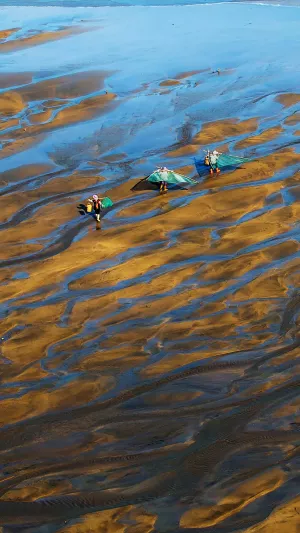Tidal flats encompass the collective term for coastal beaches, riverbanks, and lake shores.
The intertidal zone in geomorphology refers to the transitional areas located between the levels of high tide and low tide in coastal regions, encompassing not only the water levels of rivers, lakes, reservoirs, and ponds, but also their corresponding normal water level, flood level, normal water storage level, and maximum flood level.
The dynamic nature of tidal flats, alternating between submersion and emergence due to tidal effects, creates a unique environment. While the upper part is intermittently exposed to water, the lower section remains submerged. Despite their relatively small size, tidal flats serve as a habitat for a diverse range of marine life, including fish, shrimps, crabs, seaweed, and shellfish in Hainan.
Tidal flats, acting as a form of growing land, undergo a continuous process of reclamation from the sea. Accumulation of organic matter from surface or underground runoff, combined with nutrients carried by ocean tides and currents, fosters an environment conducive to the thriving of birds, fish, shellfish, arthropods, mollusks, and other creatures. Consequently, tidal flats stand out as one of the most vibrant ecosystems on Earth.
Functioning as a transitional zone between land and sea, tidal flats are in a state of constant change. Inland development through reclamation, along with the infusion of fresh salt, facilitates the swift formation of land for agriculture, animal husbandry, fishery, and livestock production. Progressing seaward, tidal flats become a frontier for ocean development, offering an essential foundation for aquaculture and the growth of the agricultural and marine industries.
While tidal flats are a valuable resource for agriculture and aquaculture, as well as a reservoir of diverse marine resources and minerals, their exploitation requires careful consideration. In many instances, these areas are surrounded and cultivated for better development.
However, the conversion of tidal flats into cultivated land poses a significant threat to the original ecological balance, resulting in diminished self-purification capacity and increased sedimentation that can impact nearby ports.
Humanity's comprehension of tidal flats has undergone a progressive expansion of knowledge, characterized by a gradual deepening of understanding. Historical development practices often neglected the carrying capacity of resources and the environment, leading to harmful activities such as land reclamation and environmental pollution.
These actions have detrimentally affected the ecological environment of coastal tidal flats, causing a decline in biodiversity and ecological functions. Some species of birds and mangroves are even nearing extinction, facing the imminent risk of disappearing from our ecosystems.
Categorically, tidal flats can be classified into three groups based on their material composition: rocky beaches, sandy beaches, and mudflats. The diverse characteristics of coastlines, influenced by factors like currents and river sand content, contribute to the variable nature of tidal flats. Consequently, control measures for tidal flat development differ based on the region's specific conditions.
In conclusion, vast and picturesque landscapes of tidal flats offer significant potential, particularly for tourism development in areas with long coastlines. The preservation of unique cultural landscapes, such as traditional tidal farming and labor scenes, adds to the allure. With convenient transportation and suitable policies, the government can actively support and promote tourism in these regions, fostering sustainable development.





